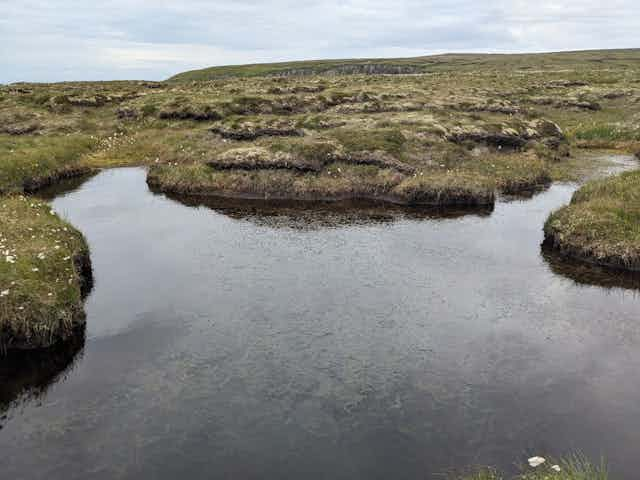Peatlands store twice as much carbon as all the world’s forests. Scotland is endowed with vast areas of these wetland ecosystems. An estimated 20% of the Scottish landscape is covered in peat soils, but 80% of these are degraded and instead release stored carbon into the atmosphere.
The Scottish government estimates that the carbon stored in its peatlands is equivalent to 120 years’ worth of the country’s emissions. Keeping it locked away is essential for moderating the climate crisis.
The Scottish government has pledged to spend £250 million between 2020 and 2030 to restore 25,000 hectares of peatland a year. This funding pays for Peatland Action, Scottish Water and other bodies to block drains, install small dams and other interventions that prevent these wetlands from drying out.

But fewer than 6,000 hectares of peatland were restored each year in 2021 and 2022 – far below the annual target. One manager at NatureScot, the government agency responsible for the environment, described the shortfall as a “national emergency” caused primarily by a “funding gap”. This is despite the government’s pledged budget not yet having been used up.
He argued that for Scotland to meet its net-zero commitments, there must be large injections of private finance into peatland restoration. Research we conducted with people who have managed peatlands for centuries tells a different story.
Crofters and carbon markets
The selling of carbon credits is supposed to direct private investment into peatland restoration. These are awarded based on the quantity of greenhouse gas emissions “avoided” as a result of restoring a peatland to health. With these credits, the buyer, whether a company or individual, can claim to have offset their own carbon footprint.
To verify that the process has actually avoided emissions, restoration projects can be accredited through the Peatland Code, a UK-backed scheme managed by the IUCN (the International Union for the Conservation of Nature).
Accreditation allows landowners to sell carbon credits on the UK land carbon registry. While some Scottish landowners have benefited from this peatland carbon market (recent reports show it has caused a spike in the price of estates containing degraded peatlands), the people who have traditionally depended most on peatland have so far seen no benefit: crofters.
Nearly one-third of Scotland’s peatlands are held in crofting tenure. Crofts, unique to the Highlands and Islands of Scotland, are tenancies that include a right to graze and extract peat (as fuel) on areas of common land which amount to 550,000 hectares nationwide. These rights are protected by laws dating from 1886, are administered by the Scottish Land Court and managed by elected committees.

Our research team travelled to the Isle of Lewis in the Outer Hebrides (an island chain off the Scottish west coast) in early 2023 to interview crofters and landowners. We found that confusion over the rights, responsibilities and benefits of selling carbon credits is slowing down restoration, not a lack of funding.
‘Pots of gold’
The Outer Hebrides has the lowest average income in the UK and the highest rate of fuel poverty in Scotland. For crofters here, the prospect of monetary compensation for restoring peatlands (where 70% of the land is classified as peatland soil) is appealing. The cost-of-living crisis has led many back to cutting peat for fuel.
Some of the people we interviewed reported carbon brokers unaffiliated with the Peatland Code visiting crofting communities and promising “pots of gold” for crofters that agreed to restore peatlands and generate carbon credits. While these brokers made out the process was simple (“restore peatlands, sell the credits to us”) the reality is more complicated.
The financial benefits of restoration are largely overstated. There is a reason rural estates with the most degraded peatland attracted the highest prices in 2022 and 2023: the more degraded the peatland is, the more carbon credits that can be generated from its restoration.
While this incentive structure targets the most degraded (and highest-emitting) areas of peatland first, it neglects many crofters who have maintained large areas of peatland in a relatively healthy condition for a long time. Where some crofters were told their peatlands were worth hundreds of thousands of pounds by carbon brokers, the reality for some areas was closer to £9,000 – and that paid over a 70-year contract period.
Muddy legal waters
These (smaller) “pots of gold” are difficult for crofters to access due to legal complications. Some of our interviewees worried that selling carbon credits was equivalent to “selling their rights” to access lands and resources held in common.
Part of the Peatland Code’s assurance when carbon credits reach the market is that the emission reduction is “permanent”. In other words, they guarantee to buyers that the peatland will remain in a restored state over the contracted timescale, which can last up to 100 years.
For crofters, this may entail limiting their rights to graze and cut peat over multiple generations. Areas of common land may need to be taken out of crofting tenure to be eligible for Peatland Code accreditation. This would involve a long legal process, if it is even feasible.
Our research with Lewisian crofters has shown that unresolved questions regarding profitability and legal complications have created a stalemate. Crofters are hesitant to commit to restoring peatlands through public funding, fearing they might miss out on financial returns if they do not engage with the carbon market. Yet doing so entails unique risks for crofting communities.
We’ve tried to fill the gap by publishing a peatland restoration guide (available in Gàidhlig and English) for crofting communities. Further advice and legal guidance for crofters – from the Peatland Code, Scottish government and the Scottish Land Court – is urgently needed to break the deadlock.

Don’t have time to read about climate change as much as you’d like?
Get a weekly roundup in your inbox instead. Every Wednesday, The Conversation’s environment editor writes Imagine, a short email that goes a little deeper into just one climate issue. Join the 30,000+ readers who’ve subscribed so far.

